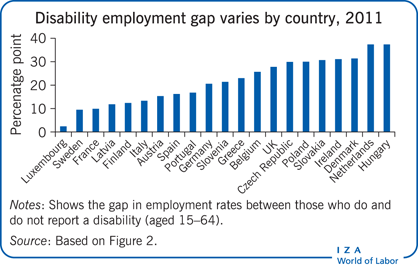Elevator pitch
In Europe, about one in eight people of working age report having a disability; that is, the presence of a long-term limiting health condition. Despite the introduction of a range of legislative and policy initiatives designed to eliminate discrimination and facilitate retention of and entry into work, disability is associated with substantial and enduring employment disadvantages. Identifying the reasons for this is complex, but critical to determine effective policy solutions that reduce the social and economic costs of disability disadvantage.

Key findings
Pros
There is growing international body of evidence regarding the labor market experience of disabled individuals.
Part of the raw gaps in labor market indicators by disability are explained by factors other than disability, including age and educational attainment.
Longitudinal evidence highlights that for many individuals who experience disability onset, it is not permanent.
Cons
There are limitations of using self-reported information on disability status from survey data.
There is consistent evidence that disability is associated with substantial labor market disadvantage, particularly in terms of employment.
Longitudinal analysis provides greater evidence of a causal influence of disability on labor market outcomes.
Disability may affect work productivity and preferences for work, making it particularly difficult to identify discrimination.
There is no consistent evidence that anti-discrimination legislation has improved the labor market outcomes of disabled individuals.